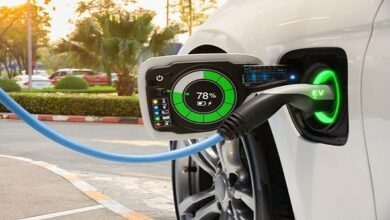Top Benefits of Switching to Electric Cars – Environmental, Financial & Everyday Advantages

Top Benefits of Switching to Electric Cars – Environmental, Financial & Everyday Advantages
As EVs become mainstream, understanding the benefits of switching to electric cars is essential—whether you’re motivated by cleaner air, lower fuel bills, or everyday convenience. From reduced emissions and cleaner city air to lower fuel bills and smoother driving, here’s why electric vehicles are compelling today.
Environmental Benefits of Electric Cars
Zero Tailpipe Emissions
Electric cars produce no tailpipe gases—so they don’t emit NOₓ, CO, hydrocarbons, or particulates, dramatically improving urban air. Reduced air pollution also translates to fewer respiratory and cardiovascular diseases.
Lower Greenhouse Gas Footprint
Even when accounting for full lifecycle emissions—including manufacturing and electricity generation—EVs typically release less greenhouse gases than conventional petrol vehicles. Efficiency gains grow as power grids decarbonize.
Enhanced Regenerative Braking
EVs regenerate braking energy, reducing wear on brake pads and lowering non-exhaust particulate pollution. This improves vehicle efficiency and contributes to lower maintenance.
Supports Renewable Energy Integration
Charging from renewable sources—like rooftop solar or wind—multiplies EVs’ environmental benefit, shifting personal transportation onto cleaner energy systems.
Energy Security & Local Emissions Reduction
Switching to electricity reduces dependence on imported oil, bolstering energy resilience. Countries like Nepal report massive oil import cost savings and smog reduction through EV adoption coupled with clean grid power.
Financial Advantages of Electric Vehicles
Lower Fuel & Operating Costs
EVs convert about 80% of electricity to movement versus 15–20% efficiency for gasoline engines. This efficiency reduces “fuel” cost per mile by 50–70%.
San Diego data shows up to $13,000 in combined state and federal incentives, and total EV operating costs are typically lower over 5 years compared to gas vehicles.
Reduced Maintenance Costs
With fewer moving parts, no oil changes, and less brake wear, EV maintenance costs are approximately 40% lower than ICE vehicles over time.
A Consumer Reports study found Teslas—the only fully-electric brand analyzed—had the lowest 10-year maintenance costs among 29 brands.
Government Incentives & Perks
Subsidies, EV rebates, HOV lane access, free city-center parking, reduced congestion charges, and tax credits (up to $7,500 US or £X depending on location) render EV ownership more financially viable.
Resale Value & Long-Term ROI
EVs may hold better resale value as demand increases. Lower running costs and incentives can yield thousands of dollars in savings over a vehicle’s lifespan. In California alone, fuel-savings estimates exceed $14,000 over 15 years.
Everyday & Performance Advantages
Smooth, Quiet Driving
Electric motors offer instant torque and whisper-quiet operation, delivering a smoother and more refined driving experience. Lower cabin vibration and reduced external noise also enhance comfort.
Superior Performance & Handling
EVs accelerate quickly from rest due to instant torque. The battery’s low center of gravity also improves handling and stability around corners.
Convenient Home Charging
Forget gas stations: plug in your EV overnight, ideally using off‑peak power or solar energy—many owners report calculating home electricity costs equivalent to $2–4 a gallon.
Bi‑Directional Charging & Energy Backup
Some EVs support vehicle-to-home or vehicle-to-grid (V2H/V2G) power export. This can power homes during outages or even earn money by feeding power back to the grid.
Reduced Noise Pollution
Quiet EV operation improves urban environments and communities. Regulations now mandate low‑speed artificial sounds to keep pedestrians safe while retaining tranquility.
Health, Community & Social Benefits
Improved Urban Air Quality
By eliminating tailpipe emissions, EV adoption significantly improves air quality in cities, reducing asthma, heart issues, and other pollution-related illnesses.
Healthier & Safer Urban Living
Less roadway pollution and noise helps lower stress and fosters communities that support walking and cycling.
Job Creation & Economic Growth
Transitioning to EVs stimulates jobs in manufacturing, charging infrastructure, and renewable energy sectors—contributing to local economies and industrial innovation.
Energy Independence
EV adoption increases a region’s resilience by reducing reliance on volatile fossil fuel markets. Local renewable generation sustains a cleaner, more stable energy future.
Summary Table of EV Benefits
| Benefit Category | What You Gain |
| Environmental | Zero tailpipe emissions, lower lifecycle CO₂, reduced air & particulate pollution |
| Financial | Up to 70% savings on fuel, ~40% lower maintenance, government incentives & grants |
| Performance & Convenience | Instant torque, quiet ride, better handling, home charging, vehicle-to-home power |
| Lifestyle & Health | Cleaner air, quieter neighborhoods, less noise pollution |
| Social & Economic | Job creation, energy independence, renewable integration, reduced oil consumption |
Considerations Before Switching
- Charging access: Home charging makes EVs most cost-efficient. Otherwise reliance on public chargers may be less convenient.
- Higher upfront cost: EVs can cost more initially, though this can be offset via incentives and long-term savings.
- Battery manufacturing emissions: EV production emits more GHG initially—but payback occurs within ~15,000 miles and total lifecycle emissions remain lower than ICE vehicles.
- Tire wear and particulate emissions: Greater weight may increase tire dust; however, regenerative braking reduces brake particulate pollution.
Real-World Example
In Western Sydney, 63% of surveyed residents expressed interest in EVs, citing lower fuel costs and smoother driving. However, 73% listed upfront cost as a barrier—underscoring the value of incentives and educating consumers on long-term benefits.
Conclusion
Switching to an electric car delivers multi-dimensional benefits: cleaner air, quieter streets, lower running costs, stronger performance, and broader health and economic advantages. Though EVs may require a higher initial investment, tax incentives and sustained savings more than compensate.
Whether through environmental stewardship, financial strategy, or daily convenience, the advantages of electric vehicles make them a smart choice for the modern driver. EVs are not just smart cars—they’re a smarter lifestyle.
FAQs
What are the main benefits of switching to electric cars?
Key benefits include zero emissions, lower operating and maintenance costs, smoother acceleration, home charging convenience, quieter operation, and health benefits from cleaner air.
Do electric vehicles cost less to own overall?
Yes—despite higher purchase costs, EVs typically cost less to fuel and maintain. Combined with incentives, many achieve lower total ownership cost within 5–10 years.
How do EVs improve air quality?
They eliminate tailpipe toxins like NOₓ and particulates, lowering respiratory risks and improving urban health.
Are electric cars reliable long term?
EVs have fewer mechanical parts and simpler systems, reducing breakdowns and lowering maintenance compared to gasoline cars.
Can EVs save on household energy bills?
Yes—charging during off‑peak or using solar energy drastically cuts costs. Some EVs can even power your home in emergencies.
How long before EV environmental savings outweigh manufacturing impacts?
Research shows EVs recoup their manufacturing carbon footprint within ~15,000 miles, after which they maintain significantly lower lifecycle emissions.
Read More About: Upcoming Affordable Electric Cars in 2025 – New EVs from BMW, Audi & More



